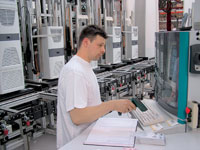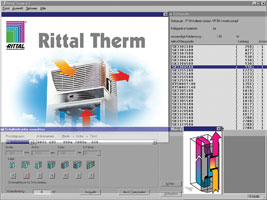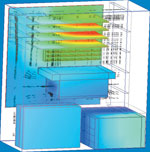
Much about electronics cooling systems was simpler in the past. If greater heat production or even dangerous heat concentrations were expected, fans were first mounted. These provided cooling airflow, gave engineers a clear conscience, and were generally sufficient to make them feel like they were on the safe side.
However, with the increase in power and packaging density of electronics, the range of sources generating heat became greater and greater to the point where it was necessary to resort to active climate control units and water cooling directly at the processor. The correct selection and sizing of the cooling components can no longer be taken lightly as this may determine the economic success and future security of the entire investment as well as the trouble-free operation of the production systems and processes.
Examples from the automotive industry illustrate clearly to what extent the demands placed on climate control systems have changed. There, production malfunctions resulting from heat-related electronics failures were previously a rarity. Yet this has become a more and more common occurrence and there are plenty of instances of converters that malfunction due to overheating. Along with the direct repair costs, this has a considerable effect on production downtimes. Renowned manufacturers of machine tools are therefore looking for ways to avoid general errors in the future by more meticulously engineering the climate control systems during the project planning phase.

Seeking: guideline for enclosure climate control
In striving for a binding 'project planning guideline for the professional construction and climate control of enclosures', the automotive industry invited the airconditioning specialists from Rittal to take on the task, or more precisely, to set the standard. Another reason for this approach was to obtain all project planning, technical expertise, responsibility and products from one source where possible and with a single business contact.
As far as enclosure climate control is concerned, Rittal has a convincing history of success to recommend itself. Since the beginning of cooling unit production in 1983, Rittal has continuously set new trends and milestones. With each new step, the benefits and efficiency are improved for consumers while at the same time reducing environmental pollution. Examples include the introduction of the first enclosure cooling unit with a microcontroller (1988), the first CFC-free cooling unit (pro-ozone initiative 1992), the first designer cooling units with the second generation of microcontrollers (1994), Rittal TopTherm cooling units with a consistent platform strategy (2002) and, more recently, the Power-Cooling system, which makes the highly efficient water cooling directly available to the processor or on cold plates. This system features simple, drip-free, maintenance-free connectors.
One major emphasis has been the implementation of CO2 cooling due to the Europe-wide ban - set to take effect in 2017 - of the current R134a standard, which has been a topic of discussion for some time now. While this halogen-free coolant does not react with the ozone layer, it still has considerable 'greenhouse effect' potential. Another innovation is RiNano, a glass-like surface coating produced using nanotechnology to prevent or reduce the collection of dirt, which, in turn, improves the efficiency of cooling devices by allowing the cooling output to remain constant over a long period of time, thereby achieving an economical use of power. RiNano-coated condensers have passed their baptism of fire under the harshest conditions in the manufacturing centres at Volkswagen.

A good service package begins in the project planning phase
Action instead of re-action: This recipe for success also ensures optimum results for enclosure climate control systems and avoids the need to 'doctor-up' symptoms later. To this end, there are a multitude of effective tools available, which can be employed individually or together depending on the complexity of the task. Here, there are often two practical possibilities: Either the customer's experienced project planner uses the tools him/herself, or concentrates on other tasks and hands over this service to a partner with the appropriate expertise at the time the inquiry is made. If this partner happens to be Rittal, the following tools and/or services are available:
Computerised project planning tools provide support during planning and help to secure the proper climate control concept. The software package Rittal Therm, for example, makes it possible to simply enter the general conditions such as desired enclosure internal temperature, surrounding temperature and heat loss parameters. It is also possible to regulate the internal air routing. The software provides an optimum cooling concept that takes all output and environmental conditions into account. This is the process by which fitted, external and roof-mounted cooling units are designed. The results conform to the specifications in VDE0660 part507 and DIN 3168. The latest software version is especially simple to operate. All required parameters from Rittal components (enclosure, climate control unit, etc.) can be accessed directly on the Rittal website and entered into the software.
CFD (computational fluid dynamics) simulation makes the optimisation of climate control systems possible even before the first prototype is built. Using complex software that takes into account the geometrical as well as the physical properties of the housing (or room) in addition to the other components, it is possible to generate a thermal image that is used as the basis for design. This makes it possible to detect critical hotspots and eliminate them by means of proper air routing. Moreover, this procedure provides valuable clues as to where temperature sensors and smoke detectors should be located to achieve the greatest benefit. Keeping in mind increasing power costs, CFD can also be used to determine the actual power output required of heat exchangers and cooling units. Simulating the failure of a cooling unit shows which components would be most greatly affected and how long it would take until a critical temperature is reached.
Thermography provides thermal images for the actual, realised object such as a prototype. A colour key indicates the effectiveness of cooling methods already applied or if there is immediate cause for further action. This makes it possible to safely detect critical items and subsequently alleviate these problems.
The climate lab is, after all, the first stop when expensive and complex assessments have to be carried out on realistically constructed systems concerning proprietary or third-party client developments. The measurements taken from the temperature and humidity sensors are evaluated using a twelve-channel data logger. The optimisation is thus reproducible and able to move forward. Specialists with many years of experience can avoid errors and detours because the items of metrological importance are usually encountered right away. The laboratory is also entrusted with the task of trimming down devices for energy efficiency. For example, master-slave operation of entire enclosure suites is optimised for better operational reliability.

Summary and outlook
When products come from one location and from a partner with a high level of systems competence, this guarantees that everything fits together in a completely unified fashion. Additionally, this avoids extraneous friction on interfaces and the ensuing errors. As has been shown here, Rittal offers a comprehensive service when it comes to climate control systems. This begins with the dimensioning of the cooling components and the provision of powerful software. Computational Fluid Dynamics with heat flow simulation allows for thermal optimisation of complete systems beginning in the project planning phase. Existing systems can be assessed using infrared thermography and likewise optimised. The climate lab offers all imaginable possibilities needed for laborious series of measurements with multi-channel evaluation of dozens of sensors. The devices and systems that are supplied are supported by a comprehensive range of services, which, for example, include on-site customer service and the worldwide supply of replacement parts.
To meet future demands and be armed with solutions before new problems emerge, a great deal of comprehensive basic research and early developments are underway. Current examples of this include the Liquid Cooling Package, which makes use of the high cooling capacity of water for an especially efficient cooling concept. In addition, the active progress of CO2 enclosure cooling units is an achievement resulting in the reduction of the greenhouse effect. In turn and in addition to technical expertise, this translates into financial clout. Therefore consulting and support comprise a considerable part of the Rittal philosophy and this is precisely the reason why they strive for a local presence, globally.
| Tel: | +27 11 609 8294 |
| Email: | [email protected] |
| www: | www.rittal.co.za |
| Articles: | More information and articles about Rittal |

© Technews Publishing (Pty) Ltd | All Rights Reserved